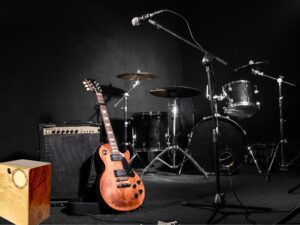

When purchasing a cajon, it’s common to wonder which of the two most recognized types of this wonderful percussion instrument to choose: the flamenco cajon or the Peruvian cajon. To make an informed decision, it’s important to understand the differences between them, which mainly involve their structure and sound.
First, it’s worth noting that the cajon originated in Afro-Peruvian culture, as it was introduced by African slaves during the Spanish colonization of the Americas in the 17th century. They used wooden boxes intended for transporting goods to accompany their songs and add a bit of colour to the grey reality they lived in. Using whatever was at hand – even a simple box – they spoke the universal language of music.
Though the flamenco cajon and the Peruvian cajon may look quite similar at first glance, there are several differences in structure, aesthetics, materials, and sound that make each one unique. Both are made of six wooden panels, with a thinner front panel and a back panel featuring an air hole.
But what exactly are the differences between these types of cajons? We’ll explain it all on the +ÍON Percussion blog.
Peruvian Cajon
This type of cajon is named for its origins in Peru, a South American country where it first developed and took shape. It gradually gained a foothold in the music world, with artists like Carlos “Caitro” Soto de la Colina championing its use. The Peruvian or traditional cajon does not have strings inside, which gives it a distinctly wooden sound when played and does not allow for tuning, limiting the musician’s ability to explore various tonal nuances.
Flamenco Cajon
The flamenco cajon is named for the modification made to the traditional cajon after Spanish musician Paco de Lucía took one to Andalusia, having been captivated by the instrument during a tour of Peru in 1977. It was at this point that strings were added inside the cajon, attached to the front panel. This addition enhanced the cajon’s tonal options, giving it a grittier sound. Flamenco cajons may have a single string or multiple strings; the more strings there are, the richer the high-pitched tones will be. Some models of flamenco cajon come with tuneable strings, giving the player greater flexibility to adjust the sound to their own taste, from bright to dry.
Cajon with drum heads: the evolution of the cajon
As musicians who are passionate about the cajon, we at +ÍON Percussion decided to take this instrument to a new level. To do so, we developed and patented an exclusive system incorporating interchangeable and tuneable drum heads into the flamenco cajon, which we call íons. These drum heads are inspired by iconic percussion instruments like the djembe, darbuka, and bongo. This expands the possibilities of blending rhythms and styles by combining these drum heads with the front panel, offering a new musical experience accessible to everyone.
The +ÍON cajon is handcrafted and sustainably made. Its versatility offers musicians great comfort when playing and traveling, as it functions as three instruments in one. It’s a way to travel the world through percussion sounds. Our cajons also feature a double tuneable string system, extended seating surface, ergonomic corners and bass output enhancer.
The choice of cajon type depends on the musician’s tastes and needs. This percussion instrument has evolved over time, and at +ÍON Percussion, we continue to innovate constantly to provide musicians with a unique experience. Visit our online store to view our cajon models and place your order.
Open your mind and join the cajon revolution!
We use cookies to ensure that we give you the best experience on our website. If you continue to use this site we will assume that you are happy with it.
Recent Comments